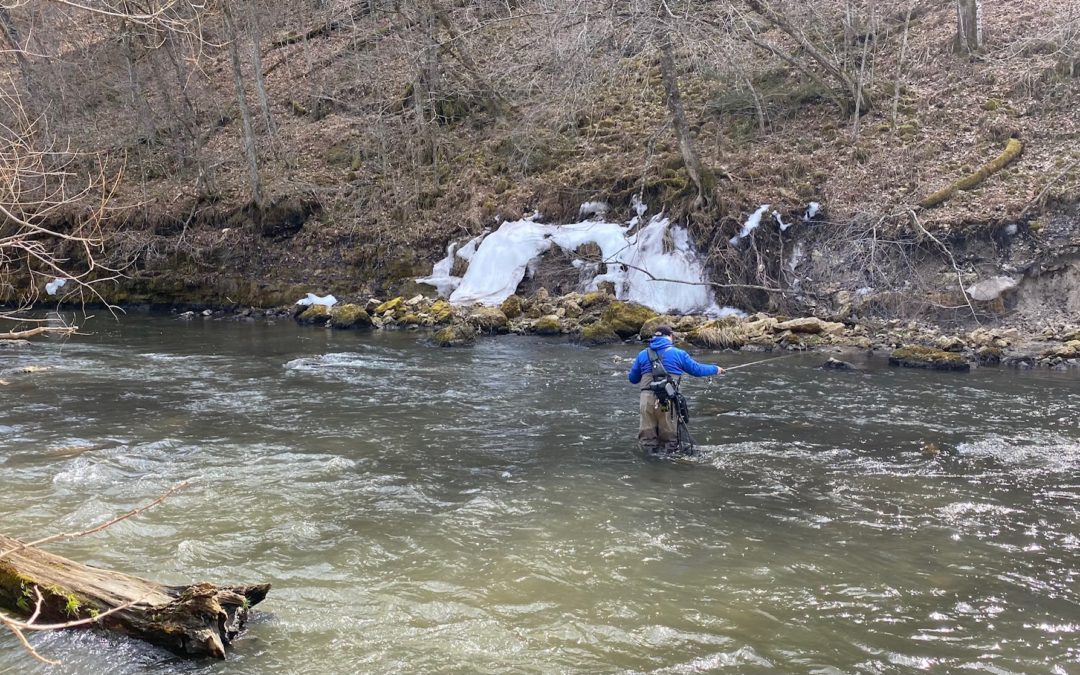Let’s begin by recognizing that Trout Unlimited is not a fly-fishing club, it’s a conservation organization dedicated to trout and cold water fisheries. It’s motto could be, “What’s good for the trout is good for the trout angler.” Founded in 1959, TU accepts any trout angler who wants to help conserve and protect trout and the cold-water habitat they rely on. Angling methods, whether bait, fly or spinner, are less important than your desire to protect and conserve.
Among Great Lakes steelhead anglers there’s a technique that calls for a fly rod fitted with a fly reel loaded with monofilament. The advantage of this rig is twofold: the fly rod, generally longer than a spinning rod, extends the anglers ability to lengthen the cast and control the drift, and the thinner mono allows the spawn sack, egg, or fly to sink deeper faster because it is less subject to the vagaries of the current.
Years ago, there was a debate in the Fly Shop about what actually defined fly fishing. At that time a veritable hoard of guys would crowd the shop every Wednesday to drink coffee, trade the same old stories, and debate various issues, one of which was what defined fly fishing. We called them “the Lost Boys.” Gordy was the one member of this unofficial club whose life had purpose; he fished every day, no excep- tions. While he had explored every method of catching trout on a fly and was an excellent caster, his favored method of trout fishing was with mono because he recognized its advantages. With a weighted nymph or two, split shot, and a wood strike indicator, Gordy relied on the weight of his rig to make the cast. The Lost Boys rejected this method as “spin fishing” with a fly. And therein lies the debate.
If you want to practice your spin casting you need your rod, reel spooled with mono, and a lure or plug because it’s the weight of the lure that pulls line from the reel. If you want to practice your fly casting you need your rod, reel, fly line (which supplies the weight), and something that could pass as a leader. You wouldn’t need a fly because a fly weighs nothing. So, what defines fly casting, as well as fly fishing, is the fly line.
Bruce Maher and Bob Trevis wrote an excellent article in the January RIPRAP about Tenkara and Euro Nymphing as trout fishing techniques. Tenkara relies on rods that are long and willowy and a short “line.” What they describe is either level fluorocarbon or braided or furled nylon. Both are described as roughly the length of the rod, 10′ to over 14′. Approximately 3′ of tippet is attached to the end and a fly attached to that. I’ve frequently thought that Tenkara, because the rods telescope to 20″, would be an ideal lightweight outfit for backpacking into those small mountain streams I love. But to make a point, the authors admit that the “line” rarely touches the water and in fact is not cast in the traditional sense. Likewise, in their description of Euro Nymphing, they explain that the fly line, usually only a foot or two beyond the tip top, also rarely touches the water. With a 20′ leader and heavily weighted nymphs the angler is actually casting the weighted nymphs, not the fly line, copying Gordy’s tech- nique. If you think a 20′ leader is kinda long, brace yourself; I found a leader formula that was 45′.
Both of these methods, Tenkara and Euro Nymphing, are legiti- mate and excellent fish catching techniques. Maher and Trevis should be applauded for introducing us to these techniques, and we could all stand to adapt some of these ideas into our fishing repertoire. Absent a fly line, however, is it fly fishing or is it spin fishing with a fly? Therein lies the debate.


